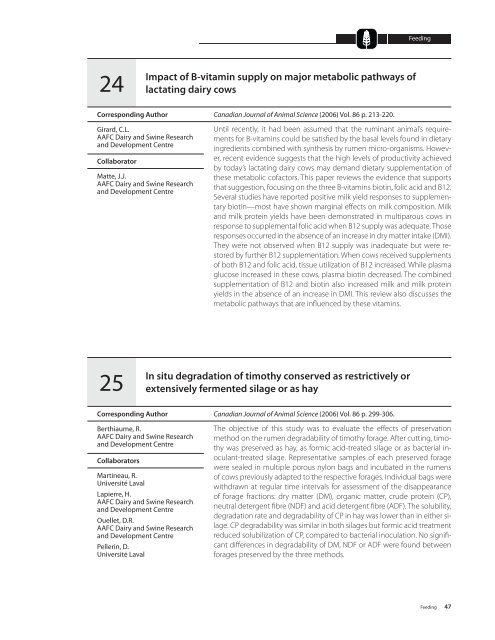A52-75-2007E.pdf - AgroMedia International Inc
A52-75-2007E.pdf - AgroMedia International Inc
A52-75-2007E.pdf - AgroMedia International Inc
Create successful ePaper yourself
Turn your PDF publications into a flip-book with our unique Google optimized e-Paper software.
Feeding24Impact of B-vitamin supply on major metabolic pathways oflactating dairy cowsCorresponding AuthorGirard, C.L.AAFC Dairy and Swine Researchand Development CentreCollaboratorMatte, J.J.AAFC Dairy and Swine Researchand Development CentreCanadian Journal of Animal Science (2006) Vol. 86 p. 213-220.Until recently, it had been assumed that the ruminant animal’s requirementsfor B-vitamins could be satisfied by the basal levels found in dietaryingredients combined with synthesis by rumen micro-organisms. However,recent evidence suggests that the high levels of productivity achievedby today’s lactating dairy cows may demand dietary supplementation ofthese metabolic cofactors. This paper reviews the evidence that supportsthat suggestion, focusing on the three B-vitamins biotin, folic acid and B12.Several studies have reported positive milk yield responses to supplementarybiotin—most have shown marginal effects on milk composition. Milkand milk protein yields have been demonstrated in multiparous cows inresponse to supplemental folic acid when B12 supply was adequate. Thoseresponses occurred in the absence of an increase in dry matter intake (DMI).They were not observed when B12 supply was inadequate but were restoredby further B12 supplementation. When cows received supplementsof both B12 and folic acid, tissue utilization of B12 increased. While plasmaglucose increased in these cows, plasma biotin decreased. The combinedsupplementation of B12 and biotin also increased milk and milk proteinyields in the absence of an increase in DMI. This review also discusses themetabolic pathways that are influenced by these vitamins.25In situ degradation of timothy conserved as restrictively orextensively fermented silage or as hayCorresponding AuthorBerthiaume, R.AAFC Dairy and Swine Researchand Development CentreCollaboratorsMartineau, R.Université LavalLapierre, H.AAFC Dairy and Swine Researchand Development CentreOuellet, D.R.AAFC Dairy and Swine Researchand Development CentrePellerin, D.Université LavalCanadian Journal of Animal Science (2006) Vol. 86 p. 299-306.The objective of this study was to evaluate the effects of preservationmethod on the rumen degradability of timothy forage. After cutting, timothywas preserved as hay, as formic acid-treated silage or as bacterial inoculant-treatedsilage. Representative samples of each preserved foragewere sealed in multiple porous nylon bags and incubated in the rumensof cows previously adapted to the respective forages. Individual bags werewithdrawn at regular time intervals for assessment of the disappearanceof forage fractions: dry matter (DM), organic matter, crude protein (CP),neutral detergent fibre (NDF) and acid detergent fibre (ADF). The solubility,degradation rate and degradability of CP in hay was lower than in either silage.CP degradability was similar in both silages but formic acid treatmentreduced solubilization of CP, compared to bacterial inoculation. No significantdifferences in degradability of DM, NDF or ADF were found betweenforages preserved by the three methods.Feeding 47





